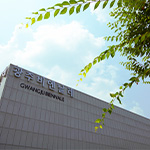Coinciding with the 30th anniversary of the Gwangju Biennale, the 15th Gwangju Biennale is titled Pansori, a soundscape of the 21st century.
Sustainable Spaces
Disputed borders, anti-migration walls, confinement, social distancing, segregation policies… These seemingly dissimilar topics share a common point, which is space, and its political organization. The main effect of climate change is the emergence of a new topology, a new world map in which carbon dioxide and urban life, desertification and migration, deforestation and social struggles, destruction of animal habitats and vegetal invasions, have all become brutally interconnected. Pansori, a soundscape of the 21st century is an operatic exhibition about the space we live in, from housing to human settlement on the planet.
But a landscape is also a soundscape, and this exhibition is constructed as a narrative, which connects musical and visual forms. Pansori, which appeared in the 17th century in Korea, is a musical genre anchored in its native territory, a symbol of the relationships between sound and space. In Korean, pansori literally means “the noise from the public place”, which could also now be translated as “the voice of the subalterns”. The 15th Gwangju Biennale intends to recreate the original spirit of pansori, inviting artists who explore contemporary space through their dialogue with surrounding living forms.
Art is also a specific place, which allows us to re-think the space shared between humans, machines, animals, spirits, and organic life — our relational space. Space is also a crossroads that connects all emancipatory struggles, from feminism to decolonization, as the division of space is always geopolitical.
The artists in this exhibition address spatial issues either by representing contemporary landscapes and the urban condition, saturated with human presence, or the effects of industrialization upon natural ecosystems. Some open up our space by entering into dialogue with machines, animals, spirits, bacteria, and other life forms, or examining the molecular composition of the world. Still others work at a cosmic scale, inventing a contemporary shamanism. From extremely dense to desertified areas, Pansori, a soundscape of the 21st century presents itself as an opera you can walk into.
Gwangju Biennale Exhibition Hall and external sites in a historical neighborhood
Three sound patterns function as spatial metaphors in the exhibition: a feedback effect (also called the Larsen effect), generated by the lack of space between two emitters. Polyphony, which is the intertwining of sounds coming from diverse sources. And the primordial sound (“Ôm” in the Hindu tradition, or the residual sound of the original Big Bang, according to contemporary science). Even if a significant number of artists in the show work directly with sound, those patterns are mainly used here to define a certain type of space.
The first part of the exhibition begins at the Gwangju Biennale Exhibition Hall. In the leading segment (Gallery 1 and Gallery 2), the feedback effect offers a sonic image for a saturated space, a planet which has become an echo chamber where everything is contiguous, contagious, and immediate. In a world saturated with human activities, both interhuman and interspecies relations become more intense. The following segment (Gallery 3) gathers artists who are addressing a multi-focused and multi-layered universe. In the final segment (Gallery 4 and Gallery 5), artists explore the non-human world and ‘two immensities’: the cosmos and the molecular realm in which glyphosate, carbon dioxide, tear gas, endocrine disruptors, droplets and viruses have become true agents of history.
The second part of the exhibition will be presented in the historical neighborhood of Yangnim-dong, focusing on sound projects and collaborative works.
Introductory video essay ‘Learning from Pansori’ and a rich lineup of events
Directed by Nicolas Bourriaud, the 15th Gwangju Biennale will feature a dynamic program that encompasses an exhibition, an opening opera, which features a song written in collaboration between Han Kang and the Seoul band WeMu, and a symposium bringing together artists and philosophers.
“Learning from Pansori,” an introductory video essay directed by Nicolas Bourriaud which unveils core concepts of the 15th Gwangju Biennale, will be featured at Madang: Where We Become Us. Madang is a special archival exhibition commemorating the Gwangju Biennale’s 30th anniversary opening in Venice this April. The video essay will also be accessible online.
Press release from Gwangju Biennale Foundation
Image: Gwangju Biennale Exhibition Hall. Image courtesy of the Gwangju Biennale Foundation



